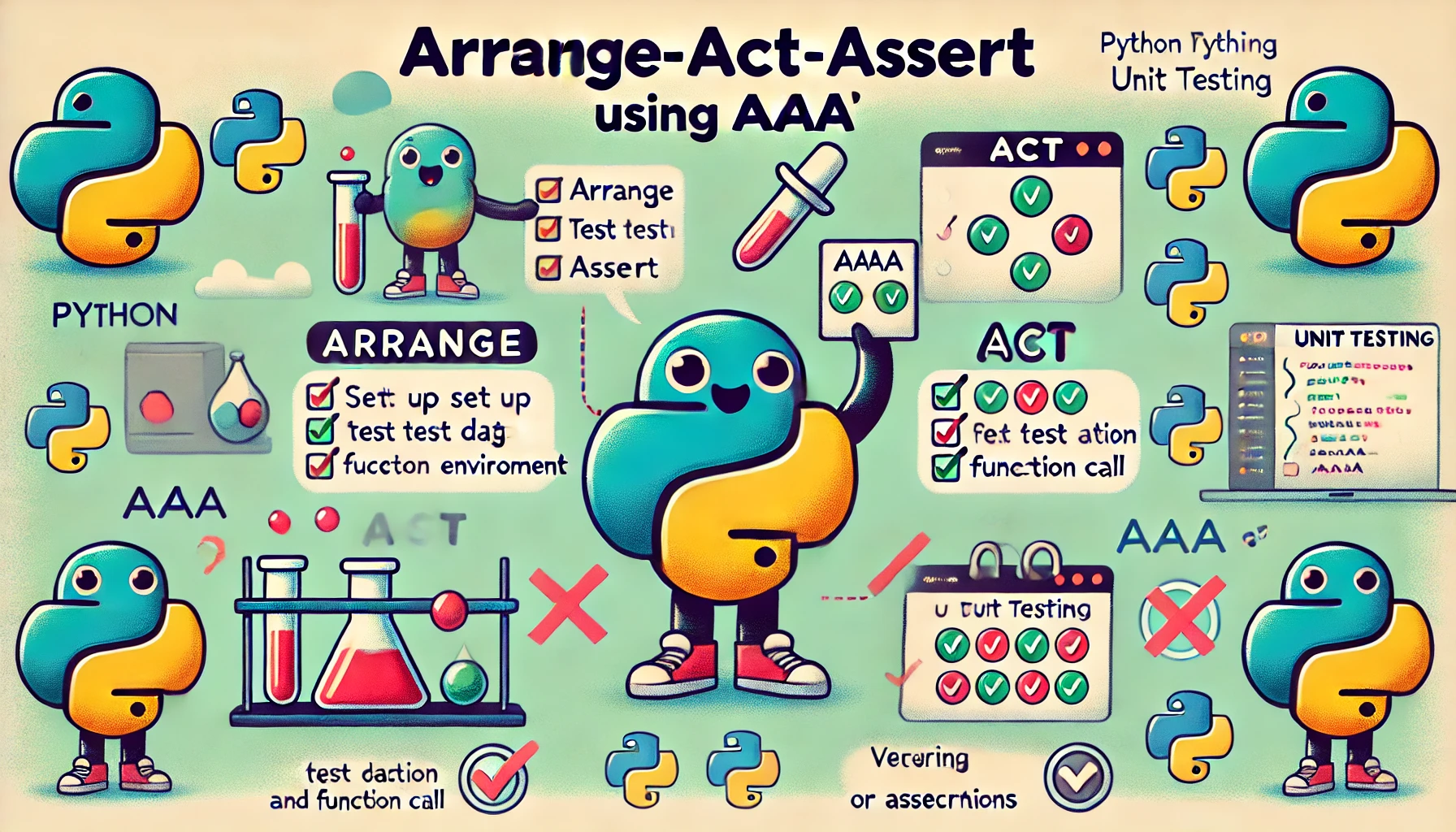Introduction to Python Unit Testing Using AAA
Unit testing is a crucial part of software development that ensures individual components of your code work as expected. The AAA (Arrange, Act, Assert) pattern is a widely adopted structure for writing clear and maintainable tests. This guide will help you understand and apply the AAA pattern to your Python unit tests.
Definition of AAA Pattern
- Arrange: Set up the necessary preconditions and inputs for the test.
- Act: Execute the code or function being tested.
- Assert: Verify that the outcome is as expected.
Example Code
Let’s create a simple function and write unit tests for it using the AAA pattern.
Function to be Tested
def multiply(a, b):
return a * bTest Case using AAA Pattern
We’ll use Python’s built-in unittest framework for writing and running the tests.
import unittest
class TestMultiplyFunction(unittest.TestCase):
def test_multiply_two_positive_numbers(self):
# Arrange
a = 3
b = 4
# Act
result = multiply(a, b)
# Assert
self.assertEqual(result, 12)
def test_multiply_positive_and_negative_number(self):
# Arrange
a = -2
b = 5
# Act
result = multiply(a, b)
# Assert
self.assertEqual(result, -10)
def test_multiply_with_zero(self):
# Arrange
a = 0
b = 10
# Act
result = multiply(a, b)
# Assert
self.assertEqual(result, 0)
def test_multiply_two_negative_numbers(self):
# Arrange
a = -3
b = -6
# Act
result = multiply(a, b)
# Assert
self.assertEqual(result, 18)
if __name__ == '__main__':
unittest.main()Tips for Writing Effective Unit Tests
- Descriptive Test Names: Use clear and descriptive names for your test methods to convey what each test is verifying.
- Test One Thing at a Time: Each test should focus on a single aspect or behavior of the function. This makes it easier to identify what goes wrong when a test fails.
- Edge Cases: Include tests for edge cases and unusual inputs to ensure your function handles all scenarios.
- Use Assertions Effectively: Utilize the various assertion methods provided by
unittestto check the expected outcomes. Common assertions includeassertEqual,assertTrue,assertFalse,assertRaises, etc. - Keep Tests Independent: Ensure tests do not depend on each other. Each test should set up its own state and clean up if necessary.
Expanded Example: Handling More Complex Logic
Function to be Tested
Let’s consider a function that checks if a string is a palindrome.
def is_palindrome(s):
s = s.lower().replace(' ', '')
return s == s[::-1]Test Case using AAA Pattern
class TestIsPalindromeFunction(unittest.TestCase):
def test_palindrome_string(self):
# Arrange
s = "Racecar"
# Act
result = is_palindrome(s)
# Assert
self.assertTrue(result)
def test_non_palindrome_string(self):
# Arrange
s = "Hello"
# Act
result = is_palindrome(s)
# Assert
self.assertFalse(result)
def test_empty_string(self):
# Arrange
s = ""
# Act
result = is_palindrome(s)
# Assert
self.assertTrue(result)
def test_palindrome_with_spaces(self):
# Arrange
s = "A man a plan a canal Panama"
# Act
result = is_palindrome(s)
# Assert
self.assertTrue(result)
if __name__ == '__main__':
unittest.main()Conclusion
By following the AAA pattern, you can write clear and maintainable unit tests that effectively verify the behavior of your code. Using unittest in Python, along with the tips provided, you can ensure your tests are well-structured, cover various scenarios, and help maintain the quality of your software.
Understanding and Writing Python Test Cases Using AAA
The AAA pattern stands for Arrange, Act, and Assert, and it is a common structure for writing unit tests. This pattern helps in organizing tests clearly, making them easy to read and maintain.
Definition
- Arrange: Set up the initial conditions and inputs for the test.
- Act: Execute the code being tested.
- Assert: Verify that the outcome is as expected.
Example Code
Let’s write a test case for a simple function that adds two numbers.
Function to be Tested
def add(a, b):
return a + bTest Case using AAA Pattern
import unittest
class TestAddFunction(unittest.TestCase):
def test_add_two_positive_numbers(self):
# Arrange
a = 3
b = 5
# Act
result = add(a, b)
# Assert
self.assertEqual(result, 8)
def test_add_positive_and_negative_number(self):
# Arrange
a = 10
b = -3
# Act
result = add(a, b)
# Assert
self.assertEqual(result, 7)
def test_add_two_negative_numbers(self):
# Arrange
a = -4
b = -6
# Act
result = add(a, b)
# Assert
self.assertEqual(result, -10)
if __name__ == '__main__':
unittest.main()Tips for Writing Effective Test Cases
- Clear and Descriptive Names: Name your test functions clearly to describe what they test. This makes it easier to understand what the test is doing at a glance.
- Single Responsibility: Each test should check a single behavior or scenario. This helps in pinpointing failures and makes tests easier to understand.
- Use Assertions: Leverage assertions to verify that the outcome is as expected. Common assertions in
unittestincludeassertEqual,assertTrue,assertFalse,assertRaises, etc. - Test Edge Cases: Make sure to include tests for edge cases and unusual inputs to ensure your function handles all scenarios correctly.
- Run Tests Regularly: Integrate your tests into your development workflow, running them frequently to catch issues early.
Expanded Example: Handling More Complex Logic
Function to be Tested
Let’s add a more complex function that checks if a number is prime.
def is_prime(n):
if n <= 1:
return False
for i in range(2, int(n ** 0.5) + 1):
if n % i == 0:
return False
return TrueTest Case using AAA Pattern
class TestIsPrimeFunction(unittest.TestCase):
def test_prime_number(self):
# Arrange
n = 7
# Act
result = is_prime(n)
# Assert
self.assertTrue(result)
def test_non_prime_number(self):
# Arrange
n = 8
# Act
result = is_prime(n)
# Assert
self.assertFalse(result)
def test_one_is_not_prime(self):
# Arrange
n = 1
# Act
result = is_prime(n)
# Assert
self.assertFalse(result)
def test_negative_number_is_not_prime(self):
# Arrange
n = -5
# Act
result = is_prime(n)
# Assert
self.assertFalse(result)
if __name__ == '__main__':
unittest.main()Conclusion
Using the AAA pattern helps structure your test cases in a clear and understandable way. By following the tips provided and practicing writing tests, you can ensure your code is robust, reliable, and maintainable.
Recommend Resources:
Python Tutorial: Unit Testing Your Code with the unittest Module Corey Schafer

Leave a Reply